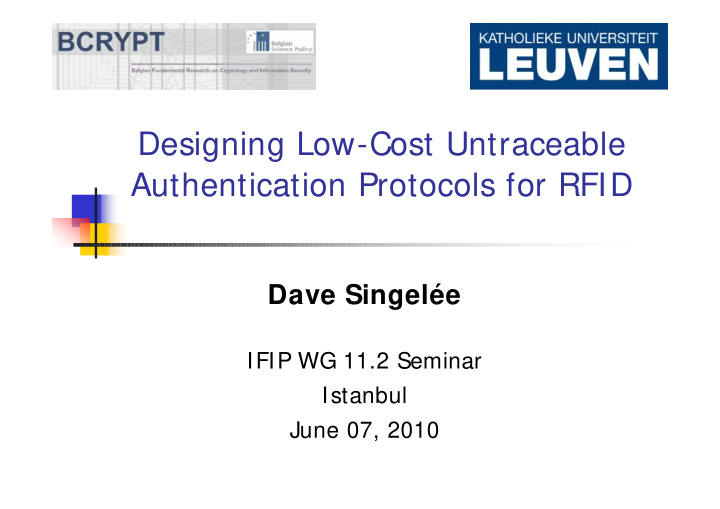



Designing Low-Cost Untraceable Authentication Protocols for RFID Dave Singelée IFIP WG 11.2 Seminar Istanbul June 07, 2010
Outline of the talk n Introduction n RFID authentication protocols n Security requirements n Privacy requirements n Implementation requirements n ECC-based RFID authentication protocols n Design challenges n Conclusion
RFID technology n Radio Frequency Identification n RFID setup n Back-end server n Reader n Tag
Online vs offline scenario n Online n Offline
RFID tags Various types of tags n Passive tag 1. Battery assisted (BAP) 2. Active tag with onboard power source 3.
RFID authentication protocols n Tag proves its identity n Challenge-response protocol Reader Tag Challenge Response
Requirements n Security n Entity authentication n Privacy n Untraceability n Implementation issues n Scalability n Low-cost
RFID security problems (I) n Impersonation attacks n Genuine readers n Malicious tags = > Tag-to-server authentication
RFID security problems (II) n Eavesdropping n Replay attacks n Man-in-the-middle attacks n Cloning n Side-channel attacks n …
RFID privacy problems (I) n RFID Privacy problem n Malicious readers n Genuine tags = > Untraceability
RFID privacy problems (II) n Anonymity n The (fixed) identity of a tag must be impossible to determine n Untraceability n Inequality of two tags: the (in)equality of two tags must be impossible to determine n Untraceability > anonymity
RFID privacy problems (III) n Theoretical framework n Vaudenay [ASIACRYPT ‘07]: n 8 privacy classes Weak Forward Destructive Strong Narrow X X X X X X X X Wide n Public-key cryptography needed to achieve certain privacy properties!!!
Implementation issues n Scalability n Low-cost implementation n Memory n Gate area n Lightweight n Efficient = > Depends on cryptographic building blocks used in the protocol
Implementation cost Symmetric encryption n AES: 3-4 kgates n Cryptographic hash function n SHA-3: 10 – 30 kgates ) n [ECRYPT II: SHA-3 Zoo] Public-key encryption n Elliptic Curve Cryptography (ECC): 11-15 kgates n = > Public key cryptography is suitable for RFI D
ECC-based RFID authentication protocols n Rely exclusively on ECC !!! n Security requirements n Privacy requirements n Implementation requirements n Schnorr protocol n Randomized Schnorr n ID-transfer scheme n …
ID-transfer scheme [WISEC 2010] Tag: x 1 , Y= yP Server: y, X = x 1 P ∈ ← r , T r P ¢ T 1 t1 1 t1 r rs ∈ ¢ s 1 1 g ← + T 2 T ( r r x Y ) s 1 2 1 1 t g − − − = 1 1 ( y T T )( r ) x P s 1 2 1 1
Design challenges (I) n Readers share same private key y n Online scenario: OK n Offline scenario: n NOT OK n 1 compromised reader = > no privacy n How to solve the problem n Give unique private key to each reader? n Key updates / revocation / ... ??
Design challenges (II) n ECC-based RFID protocols in literature n Narrow-strong: OK n Wide-weak: NOT OK n Man-in-the-middle attacks n Insider attacks ⇒ Increase privacy protection ⇒ Low cost solutions
Design challenges (III) n Secure and privacy-preserving extensions of basic RFID authentication protocols n Search protocol n Grouping proofs n ... n Physical layer security n Distance bounding n Physical layer fingerprints n ...
Design challenges (IV) n Improve efficiency n Lower # EC point multiplications n Decrease communication cost n ... n Further improve ECC hardware architecture n Area n Speed n Power consumption
Conclusion n Security & privacy in RFID networks n Need for public-key based RFID authentication protocols n ECC is feasible on RFID n Designing protocol is challenging task n Various open research problems
Questions?? Dave.Singelee@esat.kuleuven.be
EXTRA SLIDES
ECC hardware architecture
Performance results Circuit Area (Gate Eq.) 14,566 Cycles for EC point multiplication 59,790 Frequency 700 KHz Power 13.8 µW Energy for EC point multiplication 1.18 µJ
Schnorr protocol [CRYPTO ‘89] Server: X = -xP Tag: x ∈ ← r , R r P ¢ R 1 1 1 1 r ∈ ¢ r 2 2 ← + v v xr r + = 2 1 vP r X R 2 1
Schnorr protocol (II) n Security: OK n Privacy: vulnerable to tracking attacks − = ⋅ − 1 ( X r R vP ) 2 1
Randomized Schnorr [CANS ‘08] Server: y, X = xP Tag: x, Y = yP ∈ ¢ r , r 2 t1 t T 1 , T 2 ← ← T r P , T r Y 1 t1 2 t2 rs ∈ ¢ r s 1 1 ← + + v v r r xr − − ⋅ − − = t 1 t 2 s 1 1 1 r ( vP T y T ) X 1 1 2 s
Randomized Schnorr (II) n Security: OK n Privacy n Narrow-strong n Not wide-weak: vulnerable to man-in-the- middle attack n Combine data from old protocol run with current protocol instance n Server accepts = > same tag = > Traceability
Randomized Schnorr (III)
ID-transfer scheme (protocol 1)

Recommend
More recommend